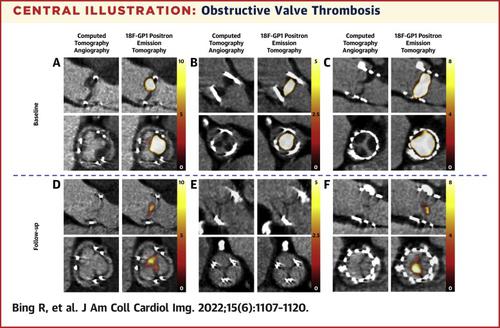JACC: Cardiovascular Imaging ( IF 14.0 ) Pub Date : 2022-01-12 , DOI: 10.1016/j.jcmg.2021.11.015 Rong Bing 1 , Marcus-André Deutsch 2 , Stephanie L Sellers 3 , Carlos Alcaide Corral 1 , Jack P M Andrews 1 , Edwin J R van Beek 4 , Sabine Bleiziffer 2 , Wolfgang Burchert 5 , Tim Clark 6 , Damini Dey 7 , Kai Friedrichs 8 , Jan F Gummert 2 , Norman Koglin 9 , Jonathon A Leipsic 3 , Oliver Lindner 5 , Mark G MacAskill 1 , Hendrik Milting 10 , Renzo Pessotto 11 , Rainer Preuss 5 , Jennifer B Raftis 1 , Tanja K Rudolph 8 , Volker Rudolph 8 , Piotr Slomka 7 , Andrew W Stephens 9 , Adriana Tavares 1 , Evangelos Tzolos 1 , Nick Weir 6 , Audrey C White 1 , Michelle C Williams 4 , Reinhard Zabel 5 , Marc R Dweck 1 , Verena Hugenberg 5 , David E Newby 1

|
Background
Bioprosthetic valve thrombosis may have implications for valve function and durability.
Objectives
Using a novel glycoprotein IIb/IIIa receptor radiotracer 18F-GP1, we investigated whether positron emission tomography (PET)-computed tomography (CT) could detect thrombus formation on bioprosthetic aortic valves.
Methods
Ex vivo experiments were performed on human platelets and explanted bioprosthetic aortic valves. In a prospective cross-sectional study, patients with either bioprosthetic or normal native aortic valves underwent echocardiography, CT angiography, and 18F-GP1 PET-CT.
Results
Flow cytometric analysis, histology, immunohistochemistry, and autoradiography demonstrated selective binding of 18F-GP1 to activated platelet glycoprotein IIb/IIIa receptors and thrombus adherent to prosthetic valves. In total, 75 participants were recruited: 53 with bioprosthetic valves (median time from implantation 37 months [IQR: 12-80 months]) and 22 with normal native aortic valves. Three participants had obstructive valve thrombosis, and a further 3 participants had asymptomatic hypoattenuated leaflet thickening on CT angiography. All bioprosthetic valves, but none of the native aortic valves, demonstrated focal 18F-GP1 uptake on the valve leaflets: median maximum target-to-background ratio 2.81 (IQR: 2.29-3.48) vs 1.43 (IQR: 1.28-1.53) (P < 0.001). Higher 18F-GP1 uptake was independently associated with duration of valve implantation and hypoattenuated leaflet thickening. All 3 participants with obstructive valve thrombosis were anticoagulated for 3 months, leading to resolution of their symptoms, improvement in mean valve gradients, and a reduction in 18F-GP1 uptake.
Conclusions
Adherence of activated platelets is a common and sustained finding on bioprosthetic aortic valves. 18F-GP1 uptake is higher in the presence of thrombus, regresses with anticoagulation, and has potential use as an adjunctive clinical tool. (18F-GP1 PET-CT to Detect Bioprosthetic Aortic Valve Thrombosis; NCT04073875)
中文翻译:

18F-GP1 正电子发射断层扫描和生物主动脉瓣血栓
背景
生物瓣膜血栓形成可能会对瓣膜功能和耐用性产生影响。
目标
使用新型糖蛋白 IIb/IIIa 受体放射性示踪剂 18F-GP1,我们研究了正电子发射断层扫描 (PET)-计算机断层扫描 (CT) 是否可以检测生物主动脉瓣上的血栓形成。
方法
对人类血小板和外植生物主动脉瓣进行离体实验。在一项前瞻性横断面研究中,使用生物瓣膜或正常自体主动脉瓣的患者接受了超声心动图、CT 血管造影和 18F-GP1 PET-CT。
结果
流式细胞术分析、组织学、免疫组织化学和放射自显影证明 18F-GP1 选择性结合激活的血小板糖蛋白 IIb/IIIa 受体和粘附于人工瓣膜的血栓。总共招募了 75 名参与者:53 名使用生物瓣膜(植入后中位时间 37 个月 [IQR:12-80 个月]),22 名使用正常的天然主动脉瓣。3 名参与者患有阻塞性瓣膜血栓,另外 3 名参与者在 CT 血管造影中出现无症状的低衰减瓣叶增厚。所有生物瓣膜(但没有天然主动脉瓣)在瓣叶上表现出局灶性 18F-GP1 摄取:中位最大目标与背景比为 2.81(IQR:2.29-3.48)vs 1.43(IQR:1.28-1.53)(P < 0.001)。较高的 18F-GP1 摄取与瓣膜植入持续时间和低衰减的小叶增厚独立相关。所有 3 名患有阻塞性瓣膜血栓的参与者均接受了 3 个月的抗凝治疗,症状得到缓解,平均瓣膜压差得到改善,并且 18F-GP1 摄取减少。
结论
活化血小板的粘附是生物主动脉瓣上常见且持续的发现。存在血栓时 18F-GP1 的摄取较高,抗凝作用会消退,并且具有作为辅助临床工具的潜在用途。(18F-GP1 PET-CT 用于检测生物主动脉瓣血栓形成;NCT04073875)



























 京公网安备 11010802027423号
京公网安备 11010802027423号